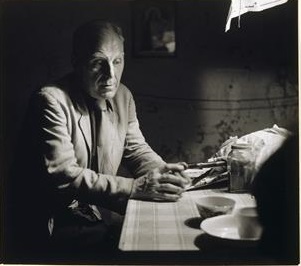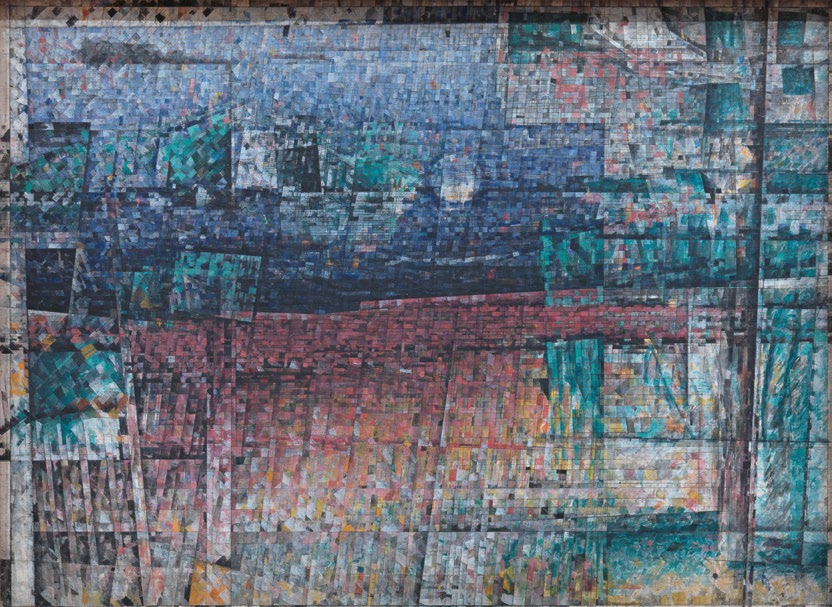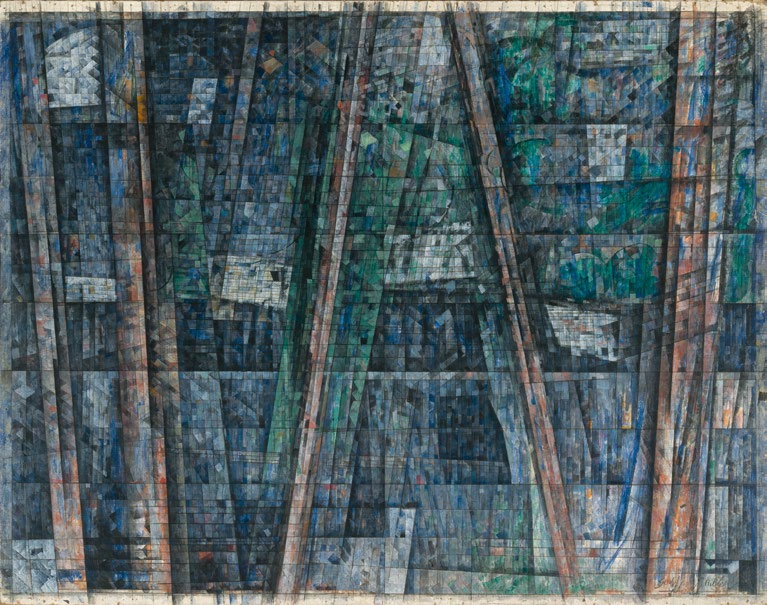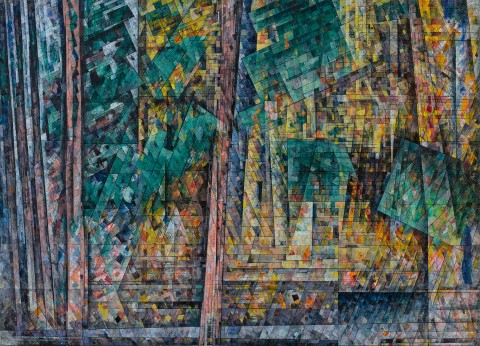TREES IN QUARRY, c.1952 – 56
GODFREY MILLER
oil, pen and ink on canvas
44.0 x 59.5 cm
signed lower right: Godfrey Miller
Macquarie Galleries, Sydney
Harold E. Mertz, Texas, USA
Archer M. Huntington Art Gallery, University of Texas, Austin, gift from the above in 1972 (label attached verso)
The Harold E Mertz Collection of Australian Art, Christie’s, Melbourne, 28 June 2000, lot 65
The Cbus Collection of Australian Art, Melbourne, acquired from the above
Godfrey Miller, Macquarie Galleries, Sydney, 7 – 19 August 1957, cat. 6
Godfrey Miller Retrospective, National Gallery of Victoria, Melbourne, 10 June – 17 July 1959, cat. 14
Godfrey Miller Memorial Exhibition, Darlinghurst Galleries, Sydney, 16 February – 27 March 1965, cat. 11
The Mertz Collection of Contemporary Australian Painting, National Gallery of South Australia, Adelaide, 10 March – 11 April 1966, cat. 58
The Australian Painters 1964 – 66: Contemporary Australian Painting from the Mertz Collection, The Corcoran Gallery of Art, Washington, 10 March – 16 April 1967, pl.21, cat. 72 (illus. in exhibition catalogue, p. 65)
on long-term loan to the National Gallery of Australia, Canberra, 1979 – c.1987
Godfrey Miller 1893 – 1964, Art Gallery of New South Wales, Sydney, 15 March – 5 May 1996; National Gallery of Victoria, Melbourne, 15 May – 17 June 1996, cat. 61 (label attached verso)
One, Two, See: Maths in a Visual World, Wollongong City Gallery, New South Wales, 2003
Colour and Movement, Benalla Art Gallery, Victoria, 19 February – 9 June 2016
on long term loan to Newcastle Art Gallery, New South Wales, prior to 2006
on long term loan to Wollongong City Gallery, New South Wales
Henshaw, J., Godfrey Miller, Darlinghurst Galleries, Sydney, 1965, n.p., pl. 18 (illus.)
Gleeson, J., Masterpieces of Australian Painting, Lansdowne Press, Melbourne, 1969, pl. 47A (illus.), p. 125
Gleeson, J., Modern Painters 1931–1970, Lansdowne Press, Melbourne, 1971, pl. 21, pp. 3, 32 (illus.), 85, 86
Edwards, D., Godfrey Miller 1893 – 1964, Art Gallery of New South Wales, Sydney, 1996, pl. 61, pp. 69 (illus.), 75, 123
Nainby, B., Stanhope, Z., and Furlonger, K., The Cbus Collection of Australian Art, in association with Latrobe Regional Gallery, Melbourne, 2009, pp. 15, 84 (illus.), 227
Trees in Quarry, 1961 – 63, pen and ink and oil on canvas, 80.5 x 92.0 cm, in the collection of the National Gallery of Victoria, Melbourne
181.1981##M.jpg

Godfrey Miller’s idiosyncratic temperament marks him as something of a contradiction in modern Australian painting. He eschewed his inherited wealth, the value placed on material existence, much about the art world and its conduct. He preferred his own privacy to the company of others. In return, the Australian art world came to regard his final decade as perhaps his finest. Miller had his first commercial exhibition in 1957, a Retrospective Exhibition in 1959 and, following his death in 1964, was included in a major exhibition of the Mertz Collection of Contemporary Australian Painting in Australia and Washington DC, with Masterpieces of Australian Painting published in 1969. Notably, on each occasion the work on offer, Trees in Quarry, c.1952 – 56, was included. In 1961, the Tate Gallery purchased Triptych with Figures, c.1944 – 50 from the landmark show, Recent Australian Painting held at Whitechapel Gallery, London over June – July that year.
Miller’s work is usually cited as belonging to a generation of mid-20th century Sydney-based artists that gave Australian modernism its confident expression of semi-abstract and non-figurative painting. Artists such as Grace Crowley, Ralph Balson and John Passmore were part of a superb ensemble, but comparisons with Passmore, whose overt debt to Cézanne is strong, are tenuous. While both Passmore and Miller shared an intellectual debt to Cézanne, their stylistic manifestations reveal distinct differences from each other. Indeed, Fairweather is a more accurate comparison, as their shared interest in esoteric and non-western philosophy shaped their art in mutually unique ways. Like Fairweather, Miller’s art unambiguously stands alone – he is unable to be categorised as belonging to a school or movement.
Born in Wellington, New Zealand, Miller wanted to become an architect. The War interrupted a promising momentum and, aged 21, he enlisted as an army private in 1914.
DH2022 CBUS Cat (July) FA (With cover added) HR (Spreads).jpg

He was off to Egypt, then Gallipoli where he was wounded, shell-shocked, and returned to Egypt. He visited Memphis and Sakkara and saw the immaculate formal clarity of Egyptian architecture, painting and sculpture. By 1916 he had been discharged and was back in New Zealand as a student at the Dunedin School of Art.
Episodic moments tended to characterise and influence Miller’s intellectual personality and career. He visited the Philippines, Japan, China and Hong Kong in 1919. In the twenties in Melbourne and nearby Warrandyte, his paintings were small, figurative, intimate and using a tonal range of exquisite subtlety. By the end of the decade, he was in London as a student at the Slade School of Fine Art where smaller scale paintings in heightened soft tones mark this period.
Two exhibitions in 1936 further refined and consolidated his outlook. Miller visited Paris on three separate occasions to see a Cézanne retrospective at the Grand Palais. In London he saw the large and vast International Exhibition of Chinese Art, held at the Royal Academy of the Arts from November 1935 – March 1936.
The Cézanne encounter provides a telling prelude to Trees in Quarry. The quarries at Bibémus, east of Aix-en-Provence, is where Cézanne first painted in 1895. The planar geometry, his tessellated brushwork and lineal accents are works of a distilled pictorial unity. But with Miller the idea of unity was not one of solely harmonised composition. Unity itself became the representation of the connectedness of everything, and had a philosophical underpinning.
DH2022 CBUS Cat (July) FA (With cover added) HR (Spreads) 2.jpg

Miller’s keen interest in mathematics, Cézanne and philosophy never diminished.1 Nothing in Miller’s work sits as isolated from its whole: no one aspect of image development supersedes another. The idea of unity, especially in non-Western thinking and culture, of interconnected relationships became an all-pervasive preoccupation. It was not only as a particular compositional understanding, but also as an expression of ideas which reinforced his art. Philosophy was central to Miller, in life and art – he had read Kandinsky’s influential text Concerning the Spiritual in Art.2
With its rich complexity we find in Trees in Quarry a mature and masterful encapsulation of Miller’s intelligently steadfast pursuits. The geometric lattice arrangement of ruled straight-line ink drawing is a familiar device. Orchestrations of withheld colour and half tones flicker and settle across a meticulously worked surface of chromatic lozenges and other shapes. No element or detail is resolutely held in place to become contained and immutable. Miller often worked on paintings for years and he regarded much of his work as incomplete. It was a considered and perpetually transient working method – as though a final resolution was a daunting prospect. In Trees in Quarry, ‘borders are everywhere, but these are borders which do not confine, as that which moves beyond things is also within them… yet radiate beyond Miller’s compositional boundary.’3 The edge is especially important as it does not seek to frame and contain but alludes to a progression and extension beyond what is seen.
Trees in Quarry remains one Miller’s most admired paintings within his lifetime and beyond. A carefully modulated density and weighting of sublime refinement reminds us that logic and mysticism might coexist as unity.
1. Wookey Edwards, A., ‘Godfrey Miller and Mathematics’ in Godfrey Miller 1893 – 1964, Art Gallery of New South Wales, Sydney, 1996, pp. 111 – 113
2. He was a member of the Royal Institute of Philosophy from 1935 – 39, joined the Anthroposophical Society, Sydney in 1939, and joined the Krishnamurti movement in 1955.
Concerning the Spiritual in Art, published in 1910 was a seminal text discussing spiritual revolution and the importance, amongst many things, of abstraction and its relationship with music.
3. Edwards, D., Godfrey Miller 1893 – 1964, Art Gallery of New South Wales, Sydney, 1996, p. 12
DOUG HALL AM
